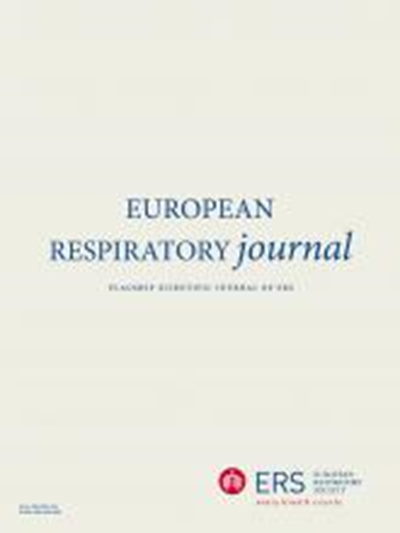Airway Tapering in Chronic Obstructive Pulmonary Disease.
IF 16.6
1区 医学
Q1 RESPIRATORY SYSTEM
引用次数: 0
Abstract
BACKGROUND Luminal narrowing is a hallmark feature of airway remodeling in COPD, but current measures focus on airway wall remodeling. Quantification of the natural increase in cumulative cross-sectional area along the length of the human airway tree can facilitate assessment of airway narrowing. METHODS We analysed the airway trees of 7641 subjects enrolled in the multicenter COPDGene cohort. Airway luminal tapering was assessed by estimating the slope of the change in cumulative cross-sectional area along the length of the airway tree over successive generations (T-Slope). We performed multivariable regression analyses to test the associations between T-Slope and lung function, St. George's Respiratory Questionnaire (SGRQ), modified Medical Research Council (mMRC) dyspnea score, 6-minute walk distance (6 MWD), FEV1 change, exacerbations, and all-cause mortality after adjusting for demographics, %CT emphysema, and total airway count. RESULTS The T-Slope decreased with increasing COPD severity: 2.69 (0.70) in nonsmokers and 2.33 (0.70), 2.11 (0.65), 1.78 (0.58), 1.60 (0.53), and 1.57 (0.52) in GOLD stages 0 through 4 respectively (Jonckheere-Terpstra p=0.04). On multivariable analyses, the T-Slope was independently associated with FEV1 (β=0.13 L, 95% CI 0.10 to 0.15, p<0.001), 6MWD (β=15.0 m, 95%CI 10.8 to 19.2, p<0.001), change in FEV1 (β=-4.50 ml·year-1, 95% CI -7.32 to -1.67; p=0.001), exacerbations (IRR=0.78, 95% CI 0.73 to 0.83, p<0.001), and mortality (HR=0.79, 95% CI 0.72 to 0.86, p<0.001). CONCLUSION T-Slope is a measure of airway luminal remodeling and is associated with respiratory morbidity and mortality.慢性阻塞性肺病的气道减容。
背景气道狭窄是慢性阻塞性肺病气道重塑的一个标志性特征,但目前的测量方法侧重于气道壁的重塑。我们分析了多中心 COPDGene 队列中 7641 名受试者的气道树。气道管腔变细是通过估算连续几代气道树长度上累积横截面积变化的斜率(T-Slope)来评估的。我们进行了多变量回归分析,以检验 T-Slope 与肺功能、圣乔治呼吸问卷 (SGRQ)、改良医学研究委员会 (mMRC) 呼吸困难评分、6 分钟步行距离 (6MWD)、FEV1 变化、病情恶化和全因死亡率之间的关系,并对人口统计学、肺气肿 %CT 和气道总数进行了调整。结果T-斜率随着慢性阻塞性肺病严重程度的增加而下降:非吸烟者为 2.69 (0.70),GOLD 0 至 4 期分别为 2.33 (0.70)、2.11 (0.65)、1.78 (0.58)、1.60 (0.53) 和 1.57 (0.52)(Jonckheere-Terpstra p=0.04)。在多变量分析中,T-斜率与 FEV1(β=0.13 L,95% CI 0.10 至 0.15,p<0.001)、6MWD(β=15.0 m,95%CI 10.8 至 19.2,p<0.001)、FEV1 变化(β=-4.50 ml-年-1,95% CI -7.32 至 -1.67; p=0.001)、病情加重(IRR=0.78,95% CI 0.73 至 0.83,p<0.001)和死亡率(HR=0.79,95% CI 0.72 至 0.86,p<0.001)。结论T-斜率是气道管腔重塑的测量指标,与呼吸系统发病率和死亡率相关。
本文章由计算机程序翻译,如有差异,请以英文原文为准。
求助全文
约1分钟内获得全文
求助全文
来源期刊

European Respiratory Journal
医学-呼吸系统
CiteScore
27.50
自引率
3.30%
发文量
345
审稿时长
2-4 weeks
期刊介绍:
The European Respiratory Journal (ERJ) is the flagship journal of the European Respiratory Society. It has a current impact factor of 24.9. The journal covers various aspects of adult and paediatric respiratory medicine, including cell biology, epidemiology, immunology, oncology, pathophysiology, imaging, occupational medicine, intensive care, sleep medicine, and thoracic surgery. In addition to original research material, the ERJ publishes editorial commentaries, reviews, short research letters, and correspondence to the editor. The articles are published continuously and collected into 12 monthly issues in two volumes per year.
 求助内容:
求助内容: 应助结果提醒方式:
应助结果提醒方式:


